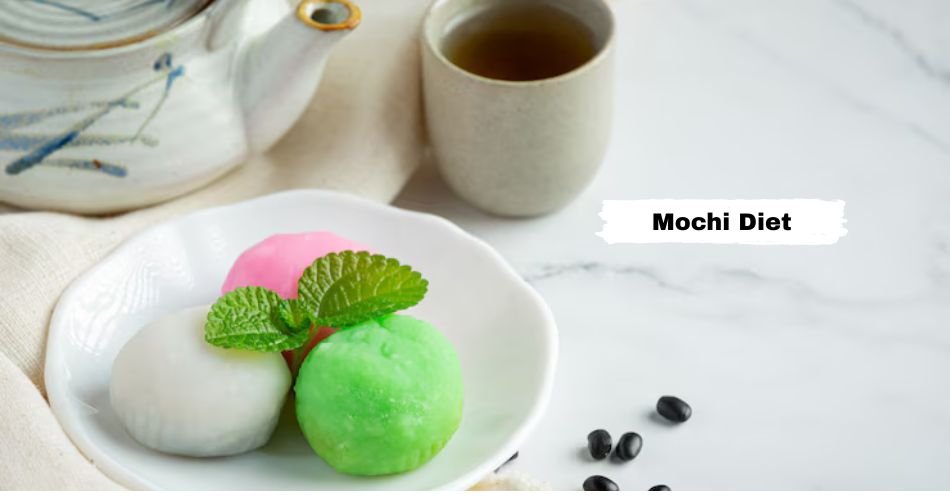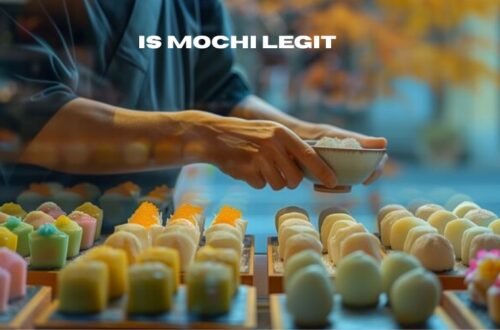The mochi diet is a modern health trend rooted in the traditional Japanese food known as mochi. This soft, chewy rice cake is made by pounding steamed glutinous rice into a sticky, elastic mass. In Japan, mochi holds deep cultural and spiritual value, often associated with celebrations and rituals, especially during the New Year. However, in recent years, this humble food has found new life in the wellness community, not only for its delightful taste and texture but also for its surprising health benefits. As people search for simple, whole-food-based diets, the mochi diet offers a unique combination of tradition, nutrition, and innovation. It allows individuals to enjoy a culturally rich food while aligning it with modern dietary goals like energy balance, gluten-free eating, and even weight management.
What Exactly Is the Mochi Diet and How Did It Gain Popularity in the Health World?
The mochi diet is not a rigid plan but rather a lifestyle that emphasizes replacing refined, processed carbohydrates with mochi as a staple carbohydrate source. Instead of reaching for bread, pasta, or sugary cereals, individuals on this diet use mochi as the main carb in meals. This switch offers a cleaner, more wholesome energy source, especially for those sensitive to gluten or looking for slow-digesting carbs. The rise in popularity of the mochi diet can be attributed to social media trends, particularly platforms like TikTok and Instagram, where influencers showcase mochi-based meal preps, weight-loss success stories, and innovative recipes. Its visually appealing texture, along with the notion of eating a “cute” food that still supports fitness and energy, makes the mochi diet an attractive option for health-conscious eaters of all ages.
Nutritional Profile of Mochi and How It Fits into a Balanced Diet
Mochi is made primarily from glutinous rice, which is a rich source of carbohydrates. A standard serving of plain mochi, about 44 grams, contains roughly 100 calories, almost all of which come from carbs. It is low in fat and contains a small amount of protein, with virtually no cholesterol. One of the mochi diet’s key advantages is that it provides sustained energy without spiking blood sugar dramatically, especially when eaten with fiber-rich or protein-packed foods. While sweet mochi varieties can be high in sugar, plain mochi remains a minimally processed option that delivers clean, slow-burning energy. When compared to more common carb sources like white bread or pasta, mochi provides fewer additives and often requires simpler preparation, which adds to its health appeal. Mochi also contains trace amounts of vitamins and minerals, such as manganese and selenium, depending on the rice used.
Health Benefits of the Mochi Diet and Why It’s More Than Just a Trend
One of the biggest health benefits of the mochi diet is its ability to provide long-lasting energy, which makes it an ideal pre- or post-workout food. Its sticky, dense consistency slows down chewing and digestion, making it more satisfying than fluffier carb sources. This promotes a feeling of fullness that can aid with portion control and reduce the likelihood of overeating. Additionally, mochi made from brown or multi-grain rice includes dietary fiber, which supports digestive health and can help regulate blood sugar levels. Since it’s naturally gluten-free, mochi also fits comfortably into the diets of those with gluten intolerance or celiac disease. The mochi diet encourages eating a simpler, whole-food-based carb, steering people away from ultra-processed alternatives, which are often loaded with hidden sugars and unhealthy fats.
Can the Mochi Diet Really Help With Weight Loss and Appetite Control?
Yes, the mochi diet has the potential to support weight loss when practiced with mindful portion control and balanced meals. One of mochi’s most helpful traits in this context is its ability to help people feel full without overeating. This is due to both its carbohydrate density and the psychological impact of its chewy texture, which naturally slows down eating and gives the body time to signal satiety. Furthermore, mochi contains resistant starch, especially when it is cooked and then cooled. Resistant starch acts similarly to dietary fiber—it is not digested in the small intestine and instead ferments in the large intestine, where it feeds healthy gut bacteria and aids in fat metabolism. Incorporating mochi into meals as a moderate, controlled portion can help reduce cravings and lead to healthier calorie intake throughout the day.
How to Structure Your Daily Meals Around the Mochi Diet for Optimal Results
Following the mochi diet does not mean eating mochi all day. Instead, it involves incorporating it strategically as a primary carbohydrate source in one or two meals per day. A typical day might start with breakfast mochi served with almond butter and banana slices, offering a balance of carbs, healthy fats, and fiber. Lunch could feature grilled mochi paired with vegetables and tofu or salmon, while dinner might skip mochi entirely in favor of lighter proteins and greens. Snacks can include small pieces of fruit-filled or savory mochi in moderation. To make the most of the mochi diet, it’s important to pair it with protein, vegetables, and healthy fats to keep meals balanced and blood sugar levels stable. Keeping hydrated and including physical activity will also amplify the diet’s benefits.
How Mochi Compares to Other Common Carbohydrate Sources in Terms of Health
When stacked against other carb sources like white rice, pasta, or white bread, mochi holds its ground as a more minimally processed, gluten-free alternative. While it is still a high-carb food, its dense texture and natural ingredients give it an edge for people seeking a more wholesome diet. Unlike many commercial breads and pastas that contain preservatives, dough conditioners, and artificial flavors, mochi made from plain rice is free from additives. Moreover, its moderate glycemic index helps maintain more stable blood sugar levels, especially when combined with other nutritious foods. The mochi diet encourages people to move away from overprocessed convenience carbs and instead embrace simplicity, which can have lasting impacts on energy, digestion, and metabolic health.
The Downsides of the Mochi Diet and What to Watch Out For
Despite its benefits, the mochi diet does come with some cautions. The sticky, chewy texture of mochi can pose a choking hazard, particularly for young children and elderly individuals. In Japan, this risk is taken seriously during festive seasons when mochi consumption increases. It’s essential to eat mochi in small, manageable bites and chew thoroughly. Another concern is the sugar content in dessert mochi. While the plain variety is quite healthy, mochi ice creams and red-bean-stuffed types often contain significant amounts of sugar, which can counteract the diet’s health goals. People with rice allergies or who are managing blood sugar-related conditions should consult a nutritionist before starting the mochi diet. Like any food-focused plan, balance and moderation are key.
Choosing the Right Kind of Mochi for Your Dieting Goals
Not all mochi is created equal. When selecting mochi for dietary purposes, it’s best to opt for plain, unsweetened varieties. Homemade mochi allows for complete control over ingredients and portion size. Alternatively, some health food stores sell mochi made with brown rice, multigrain blends, or added seeds like flax or chia, which enhance fiber and nutrient content. Store-bought mochi can be a convenient option, but it’s crucial to read labels and avoid products with artificial flavors, high-fructose corn syrup, or hydrogenated oils. Storing mochi properly also matters—keep fresh mochi in airtight containers and consume within a few days, while frozen mochi can be stored longer if sealed well.
Creative and Healthy Ways to Enjoy Mochi While Dieting
Mochi is incredibly versatile and can be used in both savory and sweet dishes. For a savory lunch or dinner, try grilled mochi skewers brushed with miso glaze or mochi cubes tossed into stir-fried vegetables. You can even flatten mochi into a crust and use it for a low-gluten pizza base. For sweet tooth cravings, mochi can be stuffed with fresh fruit, served with a drizzle of honey, or rolled in matcha powder and sesame seeds. These alternatives allow for satisfying indulgences without compromising the principles of the mochi diet. Eating mochi creatively prevents diet fatigue and helps maintain long-term consistency.
Who Should Reconsider the Mochi Diet Before Starting It
While the mochi diet can be safe and beneficial for many, it’s not for everyone. Individuals with carbohydrate restrictions, such as those managing diabetes, should consult with healthcare providers before increasing mochi intake. Also, people with digestive conditions that require low-starch diets might not tolerate mochi well. Due to the risk of choking, the mochi diet is not recommended for children under five or elderly people with swallowing difficulties. If you fall into these categories but still want to explore the benefits of mochi, consider discussing alternatives and portion sizes with a dietitian or nutritionist.
Real-Life Results and Testimonials from People Who Have Tried the Mochi Diet
Many people who adopt the mochi diet report improved energy levels, better digestion, and easier weight management. Testimonials highlight how replacing bread or pasta with mochi helped reduce bloating and improved feelings of fullness. Some users even claim that the mochi diet helped them become more mindful eaters, given mochi’s slow-chewing texture. Nutrition experts who support whole-food eating often commend the mochi diet for its simplicity and flexibility. However, they stress the importance of making mochi part of a broader, balanced eating plan rather than relying on it as a magic bullet for health or weight loss.
Is the Mochi Diet Just a Trend or Is It Here to Stay?
The mochi diet’s blend of cultural richness and health benefits gives it an enduring appeal. While it may have gained popularity through viral social media trends, its foundation in whole, natural foods ensures that it won’t disappear overnight. As people continue to explore non-Western approaches to wellness and expand their dietary horizons, the mochi diet is likely to remain a relevant and practical tool for healthy living. With increasing access to healthier mochi varieties and recipes, it’s possible that mochi will become a staple in many global kitchens—not just for celebrations, but for everyday nourishment.
Conclusion
The mochi diet is more than just a catchy food trend, it’s a celebration of simplicity, tradition, and mindful eating. Rooted in Japanese culture and shaped by modern health values, this diet offers a unique way to fuel your body with clean energy, support digestion, and even manage weight. With its satisfying texture, nutritional profile, and versatility, mochi fits seamlessly into various meal plans, making healthy eating both enjoyable and sustainable. As with any diet, moderation, balance, and personalization are key. So if you’re looking for a fresh way to rethink your carbs, the mochi diet might just be the chewy path to better health.





